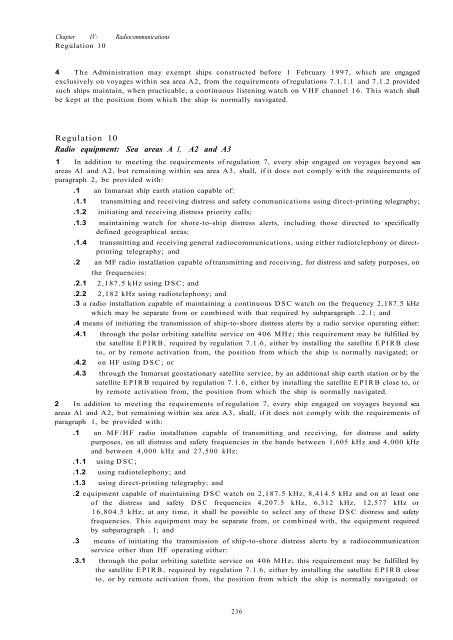Solas Consolidated Edition 2009.pdf
Solas Consolidated Edition 2009 for maritime
Solas Consolidated Edition 2009 for maritime
Create successful ePaper yourself
Turn your PDF publications into a flip-book with our unique Google optimized e-Paper software.
Chapter IV: Radiocommunications<br />
Regulation 10<br />
4 The Administration may exempt ships constructed before 1 February 1997, which are engaged<br />
exclusively on voyages within sea area A2, from the requirements of regulations 7.1.1.1 and 7.1.2 provided<br />
such ships maintain, when practicable, a continuous listening watch on VHF channel 16. This watch shall<br />
be kept at the position from which the ship is normally navigated.<br />
Regulation 10<br />
Radio equipment: Sea areas A I, A2 and A3<br />
1 In addition to meeting the requirements of regulation 7, every ship engaged on voyages beyond sea<br />
areas Al and A2, but remaining within sea area A3, shall, if it does not comply with the requirements of<br />
paragraph 2, be provided with:<br />
.1 an Inmarsat ship earth station capable of:<br />
.1.1 transmitting and receiving distress and safety communications using direct-printing telegraphy;<br />
.1.2 initiating and receiving distress priority calls;<br />
.1.3 maintaining watch for shore-to-ship distress alerts, including those directed to specifically<br />
defined geographical areas;<br />
.1.4 transmitting and receiving general radiocommunications, using either radiotclephony or directprinting<br />
telegraphy; and<br />
.2 an MF radio installation capable of transmitting and receiving, for distress and safety purposes, on<br />
the frequencies:<br />
.2.1 2,187.5 kHz using DSC; and<br />
.2.2 2,182 kHz using radiotclephony; and<br />
.3 a radio installation capable of maintaining a continuous DSC watch on the frequency 2,187.5 kHz<br />
which may be separate from or combined with that required by subparagraph .2.1; and<br />
.4 means of initiating the transmission of ship-to-shore distress alerts by a radio service operating either:<br />
.4.1 through the polar orbiting satellite service on 406 MHz; this requirement may be fulfilled by<br />
the satellite EPIRB, required by regulation 7.1.6, either by installing the satellite EPIRB close<br />
to, or by remote activation from, the position from which the ship is normally navigated; or<br />
.4.2 on HF using DSC; or<br />
.4.3 through the Inmarsat geostationary satellite service, by an additional ship earth station or by the<br />
satellite EPIRB required by regulation 7.1.6, either by installing the satellite EPIRB close to, or<br />
by remote activation from, the position from which the ship is normally navigated.<br />
2 In addition to meeting the requirements of regulation 7, every ship engaged on voyages beyond sea<br />
areas Al and A2, but remaining within sea area A3, shall, if it does not comply with the requirements of<br />
paragraph 1, be provided with:<br />
.1 an MF/HF radio installation capable of transmitting and receiving, for distress and safety<br />
purposes, on all distress and safety frequencies in the bands between 1,605 kHz and 4,000 kHz<br />
and between 4,000 kHz and 27,500 kHz:<br />
.1.1 using DSC;<br />
.1.2 using radiotelephony; and<br />
.1.3 using direct-printing telegraphy; and<br />
.2 equipment capable of maintaining DSC watch on 2,187.5 kHz, 8,414.5 kHz and on at least one<br />
of the distress and safety DSC frequencies 4,207.5 kHz, 6,312 kHz, 12,577 kHz or<br />
16,804.5 kHz; at any time, it shall be possible to select any of these DSC distress and safety<br />
frequencies. This equipment may be separate from, or combined with, the equipment required<br />
by subparagraph . 1; and<br />
.3 means of initiating the transmission of ship-to-shore distress alerts by a radiocommunication<br />
service other than HF operating either:<br />
.3.1 through the polar orbiting satellite service on 406 MHz; this requirement may be fulfilled by<br />
the satellite EPIRB, required by regulation 7.1.6, either by installing the satellite EPIRB close<br />
to, or by remote activation from, the position from which the ship is normally navigated; or<br />
236


